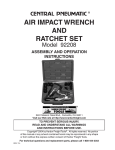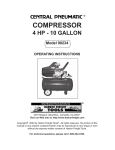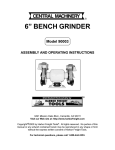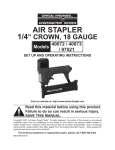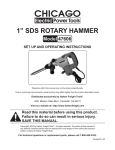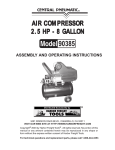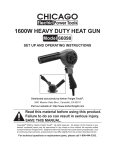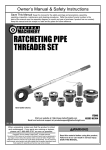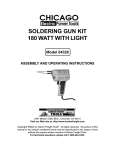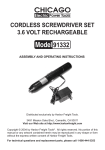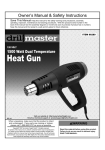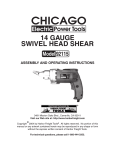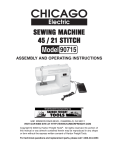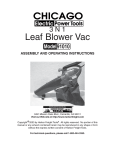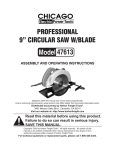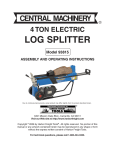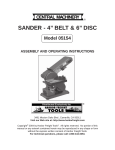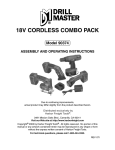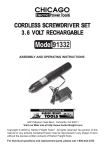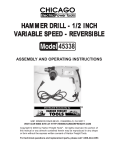Download Harbor Freight Tools 47269 User's Manual
Transcript
HEAT GUN WITH ACCESSORIES 47269 ASSEMBLY & OPERATING INSTRUCTIONS ® 3491 Mission Oaks Blvd., Camarillo, CA 93011 Visit our Web site at http://www.harborfreight.com TO PREVENT SERIOUS INJURY, READ AND UNDERSTAND ALL WARNINGS AND INSTRUCTIONS BEFORE USE. Copyright© 2002, 2004 by Harbor Freight Tools® . All rights reserved. No portion of this manual or any artwork contained herein may be reproduced in any shape or form without the express written consent of Harbor Freight Tools. For technical questions and replacement parts, please call 1-800-444-3353 THANK YOU for choosing a HARBOR FREIGHT TOOLS product. For future reference, please complete the owner’s record below: Model___________ Serial No._____________ Purchase Date_____________ Save This Manual You will need the manual for the safety warnings and precautions, assembly instructions, operating and maintenance procedures, parts list and diagram. Keep your invoice with this manual. Write the invoice number on the inside of the front cover. Keep the manual and invoice in a safe and dry place for future reference. Technical Specifications Product Name: Product Number: Motor: Heat Settings: Switch: Watt Settings: Dimensions: Pistol Grip: Product Weight: Accessories Include: Heat Gun With Accessories 47269 120 V/ 60 Hz (2) Low-630°; High-1000° 3 Way, High/Off/Low E179876 1000 Watt Low/ 1500 Watt High 9-5/8" x 8" H x 2-7/8" Diameter 5" Long with Hanger Loop 3.8 Lbs Wood Handle w/Threaded End; Putty Knife, Scrapers: Triangle Shaped, 3-Sided, and Pear Shaped; Outlet Diameter Reducer, Outlet-Flatten Discharge, Outlet-45 Degree, and Outlet-Eccentric. GENERAL SAFETY RULES WARNING! READ AND UNDERSTAND ALL INSTRUCTIONS Failure to follow all instructions listed below may result in electric shock, fire, and/or serious injury. SAVE THESE INSTRUCTIONS WORK AREA 1. Keep your work area clean and well lit. Cluttered benches and dark areas invite accidents. 2. Do not operate power tools in explosive atmospheres, such as in the presence of flammable liquids, gases, or dust. Power tools create sparks which may ignite the dust or fumes. 3. Keep bystanders, children, and visitors away while operating a power tool. Distractions can cause you to lose control. Protect others in the work area from debris such as chips and sparks. Provide barriers or shields as needed. ELECTRICAL SAFETY 4. Grounded tools must be plugged into an outlet properly installed and grounded in accordance with all codes and ordinances. Never remove the grounding prong or modify the plug in any way. Do not use any adapter plugs. Check with a qualified Continued on page 3 ITEM 47269 Page 2 electrician if you are in doubt as to whether the outlet is properly grounded. If the tools should electrically malfunction or break down, grounding provides a low resistance path to carry electricity away from the user. 5. Double insulated tools are equipped with a polarized plug (one blade is wider than the other). This plug will fit in a polarized outlet only one way. If the plug does not fit fully in the outlet, reverse the plug. If it still does not fit, contact a qualified electrician to install a polarized outlet. Do not change the plug in any way. Double insulation eliminates the need for the three wire grounded power cord and grounded power supply system. 6. Avoid body contact with grounded surfaces such as pipes, radiators, ranges, and refrigerators. There is an increased risk of electric shock if your body is grounded. 7. Do not expose power tools to rain or wet conditions. Water entering a power tool will increase the risk of electric shock. 8. Do not abuse the Power Cord. Never use the Power Cord to carry the tools or pull the Plug from an outlet. Keep the Power Cord away from heat, oil, sharp edges, or moving parts. Replace damaged Power Cords immediately. Damaged Power Cords increase the risk of electric shock. 9. When operating a power tool outside, use an outdoor extension cord marked “WA” or “W”. These extension cords are rated for outdoor use, and reduce the risk of electric shock. PERSONAL SAFETY 10. Stay alert. Watch what you are doing, and use common sense when operating a power tool. Do not use a power tool while tired or under the influence of drugs, alcohol, or medication. A moment of inattention while operating power tools may result in serious personal injury. 11. Dress properly. Do not wear loose clothing or jewelry. Contain long hair. Keep your hair, clothing, and gloves away from moving parts. Loose clothes, jewelry, or long hair can be caught in moving parts. 12. Avoid accidental starting. Be sure the Power Switch is off before plugging in. Carrying power tools with your finger on the Power Switch, or plugging in power tools with the Power Switch on, invites accidents. 13. Remove adjusting keys or wrenches before turning the power tool on. A wrench or a key that is left attached to a rotating part of the power tool may result in personal injury. 14. Do not overreach. Keep proper footing and balance at all times. Proper footing and balance enables better control of the power tool in unexpected situations. 15. Use safety equipment. Always wear ANSI approved safety goggles and a respirator mask when using this tool.-See Heat Gun Specific Instruction 6 on page 5 for further details. ITEM 47269 Page 3 TOOL USE AND CARE 16. Use clamps (not included) or other practical ways to secure and support the workpiece to a stable platform. Holding the work by hand or against your body is unstable and may lead to loss of control. 17. Do not force the tool. Use the correct tool for your application. The correct tool will do the job better and safer at the rate for which it is designed. 18. Do not use the power tool if the Power Switch does not turn it on or off. Any tool that cannot be controlled with the Power Switch is dangerous and must be replaced. 19. Disconnect the Power Cord Plug from the power source and allow the tools to cool completely before making any adjustments, changing accessories, or storing the tool. Such preventive safety measures reduce the risk of starting the tool accidentally. 20. Store idle tools out of reach of children and other untrained persons. Tools are dangerous in the hands of untrained users. 21. Maintain tools with care. Do not use a damaged tool. Tag damaged tools “Do not use” until repaired. 22. Before each use, check for breakage of parts and any other condition that may affect the tool’s operation. If damaged, have the tool serviced before using. Many accidents are caused by poorly maintained tools. 23. Use only accessories that are recommended by the manufacturer for your model. Accessories that may be suitable for one tool may become hazardous when used on another tool. SERVICE 24. Tool service must be performed only by qualified repair personnel. Service or maintenance performed by unqualified personnel could result in a risk of injury. 25. When servicing a tool, use only identical replacement parts. Follow instructions in the “Maintenance” section of this manual. Use of unauthorized parts or failure to follow maintenance instructions may create a risk of electric shock or injury. Warning: The warnings, cautions and instructions discussed in this instruction manual cannot cover all possible conditions and situations that may occur. It must be understood by the operator that COMMON SENSE AND CAUTION ARE FACTORS WHICH CANNOT BE BUILT INTO THIS PRODUCT, BUT MUST BE SUPPLIED BY THE OPERATOR. Warning: This product contains or, when used, produces a chemical known to the State of California to cause cancer and birth defects (or other reproductive harm). (California Health & Safety Code 25249.5 et seq.) ITEM 47269 Page 4 Heat Gun Specific Safety Rules Important Safety Instructions Read These Instructions WARNING: Extreme care should be taken when stripping paint. The peelings, residue and vapors of paint may contain lead, which is poisonous. Any pre-1977 paint may contain lead and paint applied to homes prior to 1950 is likely to contain lead. Once deposited on surfaces, hand to mouth contact can result in the ingestion of lead. Exposure to even low levels of lead can cause irreversible brain and nervous system damage; young and unborn children are particularly vulnerable. Before beginning any paint removal process you should determine whether the paint you are removing contains lead. This can be done by your local health department or by a professional who uses a paint analyzer to check the lead content of the paint to be removed. LEAD-BASED PAINT SHOULD ONLY BE REMOVED BY A PROFESSIONAL AND SHOULD NOT BE REMOVED USING A HEAT GUN. Persons removing paint should follow these guidelines: 1) Move the work piece outdoors. If this is not possible, keep the work area well ventilated. Open the windows and put an exhaust fan in one of them. Be sure the fan is moving the air from inside to outside. 2) Remove or cover any carpets, rugs, furniture, clothing, cooking utensils, and air ducts. 3) Place drop cloth in the work area to catch any paint chips or peelings. Wear protective clothing such as extra work shirts, overalls, and hats. 4) Work in one room at a time. Furnishings should be removed or placed in the center of the room and covered. Work areas should be sealed off from the rest of the dwelling by sealing doorways with drop cloths. 5) Children, pregnant or potentially pregnant women, and nursing mothers should not be present in the work area until the work is done and all clean up is complete. 6) Wear a dust respirator mask or a dual filter (dust and fume) respirator mask which has been approved by the Occupational Safety and Health Administration (OSHA), the National Institute of Safety and Health (NIOSH), or the United States Bureau of Mines. These masks and replaceable filters are readily available at major hardware stores. Be sure the mask fits. Beards and facial hair may keep masks from sealing properly. Change filters often. DISPOSABLE PAPER MASKS ARE NOT ADEQUATE. 7) Use caution when operating the Heat Gun. Keep the Heat Gun moving as excessive heat will generate fumes which can be inhaled by the operator. 8) Keep food and drink out of the work area. Wash hands, arms, and face and rinse mouth before eating or drinking. Do not smoke or chew gum or tobacco in the work area. 9) Clean up all removed paint and dust by wet mopping the floors. Use a wet cloth to clean all walls, sills, and any other surface where paint or dust is clinging. DO NOT SWEEP, DRY DUST OR VACUUM. Use a high phosphate detergent or trisodium phosphate (TSP) to wash and mop areas. 10) At the end of each work session put the paint chips and debris in a double plastic bag, close it with tape or twist ties, and dispose of properly. 11) Remove protective clothing and work shoes in the work area to avoid carrying dust into the rest of the dwelling. Wash work clothes separately. Wipe shoes off with a wet rag that is then washed with the work clothes. Wash hair and body thoroughly with soap and water. 12) Take caution as some woods contain preservatives such as copper chromium arsenate (CCA) which can be toxic. When working with these materials extra care should be taken to avoid inhalation and minimize skin contact. 13) People with pacemakers should consult their physician(s) before using this product. Electromagnetic fields in close proximity to a heart pacemaker could cause interference to or failure of the pacemaker. SAVE THESE INSTRUCTIONS. ITEM 47269 Page 5 Nozzle is extremely hot. When using the Heat Gun, never allow any body part to contact nozzle. Never touch any hot surface when the Heat Gun is running. Be careful to put the hot Heat Gun down only on a non-flammable surface. Never use heat Gun as a blow dryer. Never direct heat flow to any person or animal. Do not obstruct the airflow. Do not cover air outlet at any time. Do not put anything down on the nozzle. Additional Warnings and Safety Instructions Hidden areas such as behind walls, ceilings, floors, attic boards, and other panels may contain flammable materials that could be ignited by the Heat Gun when working in these locations. The ignition of these materials may not be readily apparent and could result in property damage and injury to persons. When working in these locations, keep the Heat Gun moving in a back-and-forth motion. Lingering or pausing in one spot could ignite the panel or the material behind it. GROUNDING WARNING! Improperly connecting the grounding wire can result in the risk of electric shock. Check with a qualfified electrician if you are in doubt as to whether the outlet is properly grounded. Do not modify the power cord plug provided with the tool. Never remove the grounding prong from the plug. Do not use the tool if the power cord or plug is damaged. If damaged, have it repaired by a service facility before use. If the plug will not fit the outlet, have a proper outlet installed by a qualified electrician. GROUNDED TOOLS: TOOLS WITH THREE PRONG PLUGS 1. Tools marked with “Grounding Required” have a three wire cord and three prong grounding plug. The plug must be connected to a properly grounded outlet. If the tool should electrically malfunction or break down, grounding provides a low resistance path to carry electricity away from the user, reducing the risk of electric shock. (See Figure A, next page.) 2. The grounding prong in the plug is connected through the green wire inside the cord to the grounding system in the tool. The green wire in the cord must be the only wire connected to the tool’s grounding system and must never be attached to an electrically “live” terminal. (See Figure A.) 3. Your tool must be plugged into an appropriate outlet, properly installed and grounded in accordance with all codes and ordinances. The plug and outlet should look like those in the following illustration. (See Figure A.) ITEM 47269 Page 6 FIGURE B FIGURE A DOUBLE INSULATED TOOLS: TOOLS WITH TWO PRONG PLUGS 4. Tools marked “Double Insulated” do not require grounding. They have a special double insulation system which satisfies OSHA requirements and complies with the applicable standards of Underwriters Laboratories, Inc., the Canadian Standard Association, and the National Electrical Code. (See Figure B.) 5. Double insulated tools may be used in either of the 120 volt outlets shown in the following illustration. (See Figure B.) SYMBOLOGY Double Insulated Canadian Standards Association Underwriters Laboratories, Inc. V~ A no xxxx/min. ITEM 47269 Volts Alternating Current Amperes No Load Revolutions per Minute (RPM) Page 7 EXTENSION CORDS 1. Grounded tools require a three wire extension cord. 2. As the distance from the supply outlet increases, you must use a heavier gauge extension cord. Using extension cords with inadequately sized wire causes a serious drop in voltage, resulting in loss of power and possible tool damage. (See Figure C.) 3. The smaller the gauge number of the wire, the greater the capacity of the cord. For example, a 14 gauge cord can carry a higher current than a 16 gauge cord. (See Figure C.) 4. If using more than one extension cord to make up the total length, make sure each cord contains at least the minimum wire size required. (See Figure C.) 5. If you are using one extension cord for more than one tool, add the nameplate amperes and use the sum to determine the required minimum cord size. (See Figure C.) 6. If you are using an extension cord outdoors, make sure it is marked with the suffix “W-A” (“W” in Canada) to indicate it is acceptable for outdoor use. 7. Make sure your extension cord is properly wired and in good electrical condition. Always replace a damaged extension cord or have it repaired by a qualified electrician before using it. 8. Protect your extension cords from sharp objects, excessive heat, and damp or wet areas. REQUIRED MINIMUM EXTENSION CORD GAUGE - 110 VOLT NAMEPLATE AMPERES (At Full Load) 6 8 10 12 14 16 18 20 22 24 26 28 30 EXTENSION CORD LENGTH 0-25 FT. 18 16 16 16 14 14 14 12 12 12 10 10 10 25-50 FT. 16 16 14 14 12 12 12 12 10 10 10 10 10 50-100 FT. 14 12 12 10 10 10 8 8 8 8 8 6 6 100-150 FT. 12 10 10 8 8 8 8 6 6 6 6 4 4 FIGURE C ITEM 47269 Page 8 The Heat Gun and included accessories are designed to be used to remove paint from painted surfaces. Never use the Heat Gun with chemical strippers. Other Uses for the Heat Gun 1) Shrink plastic wire nuts and other wire jointers for tight fits. 2) Remove self-adhesive trim and stickers. 3) Wax and remove wax from surfboards, skis, and snowboards. 4) Use with PVC shrink wrap sheeting for extra bonding power. 5) Thaw frozen pipes and locks. Do not use on plastic pipe! 6) Dry out damaged timber or use to highlight wood grain before staining. 7) Soften old putty prior to removal. 8) Speed up drying times for all types of paints, glues and stains. Assembly Your Heat Gun comes completely assembled. It is only necessary to select the appropriate attachment and follow the operating instructions below. Note: Performance of this tool (if powered by line voltage) may vary depending on variations in local line voltage. Extension cord usage may also affect tool performance. Operation To assist you with operation please refer to the Operational Figures as well as the Assembly Diagram and Parts List located on the last pages of this manual. Never use the Heat Gun with chemical strippers. Always clean dried paint and varnish from the nozzle after use to prevent ignition. Observe all safety precautions regarding ventilation. Lead-based paint is poisonous, and should only be removed by a professional and should not be removed using a heat gun. Step 1) Make certain to cover all surfaces that should not be heated with nonflammable material. Outlet-45 Degree Discharge Nose Cone (32) Figure D-Nose Cone with Attachment ITEM 47269 Page 9 Step 2) Select the desired and appropriate attachment for the Heat Gun. Slide the attachment onto the Nose Cone (32) -see Figure D, previous page. Step 3) Turn on the Heat Gun. The Heat Gun has a High setting, a Low setting and an OFF Setting. Push the Switch (2) in at “H” (top of Switch) for the High setting or at “L” (bottom of Switch) to run on the low setting. Allow it to reach full power and full heat. Step 4) Hold the Nose Cone (32) with attachment 3" to 4" from the surface and/or material to be heated. Step 5) If removing paint, wait until the paint begins to bubble. Use one of the three scraping attachments (Pear Shaped, Triangle Shaped, or 3-Sided) to remove it. Slide the desired scraping attachment onto the Wood Handle with Threaded End (36). Place it over one Nut (37), then tighten second Nut (38) on top of attachment. Scraper will be sandwiched between both Nuts. Note: Overheating will make the paint more difficult to remove. Clean the scraper edge frequently to prevent build up of material. Maintenance 1. Unplug the Power Cord before performing any service or maintenance on the Heat Gun. Allow the Heat Gun to cool down completely. 2. Clean the air intakes after every use. 3. Clean the Nose Cone (32) and outlet after every use. 4. Clean the housing with a normal household cleaning agent. Do not use gasoline or a similar substance to clean any part of the Heat Gun. ITEM 47269 Page 10 Unpacking When unpacking your Heat Gun in Blowmold Case, check to make sure the following parts are included. If any parts are missing or broken, please call HARBOR FREIGHT TOOLS at 1-800-444-3353. Parts List 1 2 3 4 5 6 7 8 9 10 11 12 13 14 15 16 17 18 19 20 * 21 22 23 24 Left Housing Switch Shock Proof Pad Diode Motor Tapping Screw Screw Fan Tapping Screw Vent VRI Regulator Capacitor Circuit Board Wire Conductor Tapping Screw Wire Strain Plate Right Housing Ring Sheath Power Cord Tapping Screw Fix Sleeve Ceramic Tube Cover 1 1 2 4 1 2 2 1 3 1 1 2 1 1 2 1 1 1 1 1 5 1 1 2 25 26 27 28 29 30 31 32 33 34 35 36 37 38 39 40 41 42 43 44 45 46 Heating Wire Ceramic Tube Washer Connector Piece Mica Paper Air Duct Air Locking Ring Nose Cone Tapping Screw Motor Support Label Wood Handle w/Threaded End Nut Nut Triangle Shaped Scraper 3 Sided Scraper Pear Shaped Scraper Wooden Handle Putty Knife Outlet Diameter Reducer Outlet-Flatten Discharge Outlet-45 Degree Discharge Outlet-Eccentric Discharge 1 1 1 3 1 1 1 1 1 1 1 1 1 1 1 1 1 1 1 1 1 1 Note: Some parts are listed and shown for illustration purposes only and are not available individually as replacement parts. * Power Cord only available with Sheath (19). Sold only as an assembly. ITEM 47269 Page 11 PLEASE READ THE FOLLOWING CAREFULLY THE MANUFACTURER AND/OR DISTRIBUTOR HAS PROVIDED THE PARTS DIAGRAM IN THIS MANUAL AS A REFERENCE TOOL ONLY. NEITHER THE MANUFACTURER NOR DISTRIBUTOR MAKES ANY REPRESENTATION OR WARRANTY OF ANY KIND TO THE BUYER THAT HE OR SHE IS QUALIFIED TO MAKE ANY REPAIRS TO THE PRODUCT OR THAT HE OR SHE IS QUALIFIED TO REPLACE ANY PARTS OF THE PRODUCT. IN FACT, THE MANUFACTURER AND/OR DISTRIBUTOR EXPRESSLY STATES THAT ALL REPAIRS AND PARTS REPLACEMENTS SHOULD BE UNDERTAKEN BY CERTIFIED AND LICENSED TECHNICIANS AND NOT BY THE BUYER. THE BUYER ASSUMES ALL RISK AND LIABILITY ARISING OUT OF HIS OR HER REPAIRS TO THE ORIGINAL PRODUCT OR REPLACEMENT PARTS THERETO, OR ARISING OUT OF HIS OR HER INSTALLATION OF REPLACEMENT PARTS THERETO. Assembly Diagram ITEM 47269 Page 12












